Physicist and astronomer Stefan Feeney of University College London, one of the...

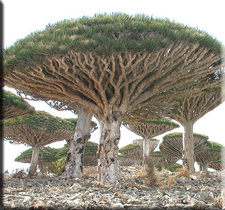
Dracaena (Dracaena draco) , or - grows in the Canary Islands in the form of giant plants.
Common name for this genus tropical plants translated into Russian means "female dragon". Probably it was a bright red resin of one of the types of dracaena - Dracaena draco. Some of the 40 species of plants in the agave family (Agavaceae) can be grown in room conditions in pots or large dishes, but the most beautiful dracaena with colorful leaves are mainly bred in heated greenhouses. Most often, Dracaena Fragrans, the fragrant dracaena, is bred at room conditions. The most famous varieties are Lindenii, Massangeana, Rotmana and Victoriae, on the leaves of which there are yellow stripes of various widths. The birthplace of dracaena is the Canary Islands, tropical regions of Africa to the archipelagos of the Pacific Ocean.
The popularity of dracaena, which is used as a single plant for the living room or hall, is constantly growing. Tall specimens are purchased for offices, and now they appear on sale much more often than before. The long-loved cordilinas tend to be more compact, but their leaves are as good as those of the dracaena, if not more attractive.
Dracaena and cordilina because of their lignified leafless stem with a bunch of leaves at the top are called false palms, they are not related to real palm trees. These majestic trees, which have long been grown as indoor plants, fit perfectly into modern interiors.

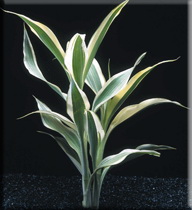
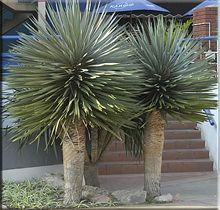
......... .................... ....................
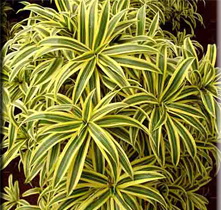
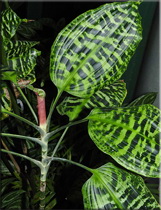
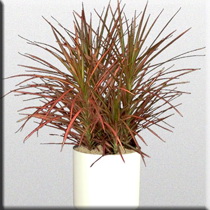
............. ..................... .......................
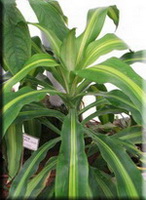
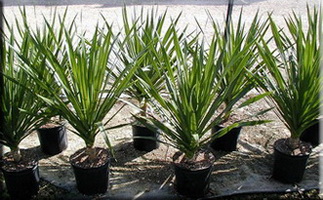
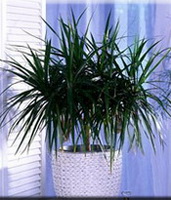
................... .....................
Temperature. Moderate, not below 15°C, most dracaena prefer a cool overwintering at a temperature of 10-12°C.
Lighting. A bright place, partial shade, does not tolerate direct sun rays. Many consider dracaena shade plant, but in fact dark place she will vegetate. Intense light is needed for good growth and development. Variegated forms require more light than green leafed forms. If there is enough light in summer, then in winter the dracaena should be rearranged closer to the window, since in winter there is usually always not enough light. Dracaena grows well under artificial lighting.
Watering. Plentiful in summer, moderate in winter, but subject to room temperature. Does not tolerate stagnant water in a pot or drying out an earthen coma. Dracaena are suitable for growing hydroponically.
Fertilizer. During the growth period from April to August, every two weeks, dracaena are fed with special complex fertilizers for indoor plants. You can use "Rainbow", "Ideal", "Giant", etc.
Air humidity. Dracaena are resistant to dry air, but require regular spraying of leaves when kept in winter in rooms with central heating. Periodically give the plant a warm shower to wash off the dust and refresh the plant.
Transfer. Spring every two years. Soil - a mixture of heavy soddy and leafy soil, rotted manure or greenhouse land with the addition of sand. The roots of dracaena are more located in the upper layer of the soil, so they make a lot of drainage in the pot.
Reproduction. Reproduction by apical cuttings or stem pieces rooted under a film in the soil at a temperature of 25 ° C.
Brown tips or edges of leaves. Most probable cause- dry air. Most dracaena require high humidity air. Other causes may be cold drafts or insufficient watering. If the reason lies in the drying of the soil at the roots, then brown spots will appear on the leaves.
Soft twisted leaves and brown edges. The reason is the temperature is too low. In delicate species of dracaena, similar signs appear if you leave them near the window on a cold night.
yellowing lower leaves. If the leaves turn yellow slowly, this is natural and inevitable for older plants. Dracaena tend to have green leaves only at the top of the bare stem. This appearance is explained by the fact that their leaves do not live long, after two years they turn yellow and die.
Brown spots on leaves. The reason is insufficient watering. The earth ball must be kept moist all the time.
Plant death. One of two things: either too abundant watering in winter, or too low a temperature.
Light dry spots on the leaves. The reason is too much sun. Move to a less lit area.
Dried plants. Without water, the plants gradually wither, at first the leaves and stems become soft, and then dry and shrivel. But it is still possible to save the plant. If it blooms, remove the flowers. You can put the plant in a vessel with water and keep it there until air bubbles stop coming out of the overdried soil. Spraying the leaves temporarily reduces the need for the plant to suck moisture out of the soil. It is useful to wrap the plant for several days in a light cloth.
Drenched plants. If the soil is oversaturated with water, the leaves become weak, the soil becomes covered with a sticky coating and diseases fall upon the plant. Tap the edge of the pot on a hard surface and remove the pot. Use a waffle towel as a desiccant - it will absorb excess water from the clod. You may need to apply the towel several times. Leave the earth ball wrapped in absorbent paper until dry, but do not overdry so that it does not crumble. When the earth ball is dry, plant the plant in a clean pot with fresh soil. Resume normal watering.
The tool is simpler, but not as effective: as much as possible, trying not to damage the roots, loosen the soil, and pour expanded clay into the pot, it will absorb excess moisture.
Tags: dracaena, dracaena, dragon tree, species of dracaena, dracaena-cinnabari, dracaena sander, dracaena bent, dracaena golden, dracaena cincta, fragrant dracaena, arborescent dracaena, fringed dracaena, dracaena care, dracaena photo, dracaena reproduction, dracaena flowers, dracaena plant, indoor dracaena, dracaena dries, dracaena leaves dry, dracaena care reproduction, dracaena species, dracaena transplant, dracaena disease, dracaena turns yellow, palm dracaena, dracaena leaves turn yellow, dracaena varieties photo, dracaena watering, dracaena species photo, dracaena leaves fall, dracaena care behind the plant, dracaena flowerpot, dracaena palm care, dracaena care watering, dracaena the tips of the leaves dry, dracaena caring for it, houseplants dracaena care.
Amateur flower growers attribute dracaena to false palm trees (recently, such a term has also appeared in flower shops). The basis for this communion is a rosette of leaves on top of a non-branching trunk.
However, these are only visual similarities (palm-shaped), otherwise dracaena have nothing in common with false palm trees.
Dracaena has earned its popularity for the variety of varieties, unpretentiousness, peculiar appearance, bright and colorful greenery.
The genus Dracaena belongs to the large Agave family with a characteristic shrubby and woody form, herbaceous and evergreen species are very rare.
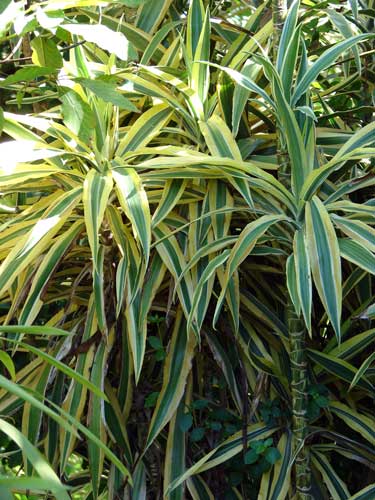
Dracaena grow in various climatic conditions: in subtropical, variable tropical and rainy forests, in savannahs, near sea coasts, woodlands and even in mountains.
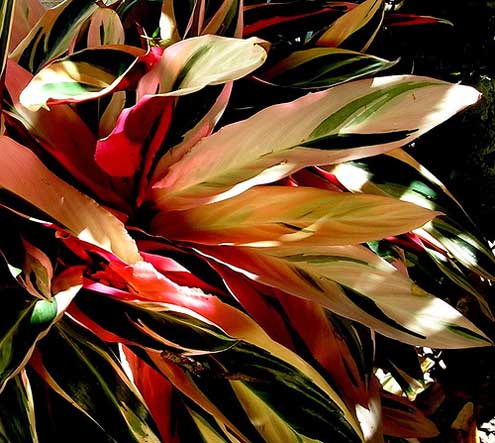
Usually slender dracaena grow in one trunk, they are also found with a branched top stem with rosette or tufts of leaves specimens.
The foliage has different shades of green with longitudinal yellow-green, white and brown stripes.
Dracaena usually almost do not bloom at room conditions. hallmark from other representatives of the Agaves - the yellowish color of the roots and the number of seeds and ovules (one ovule with one seed).
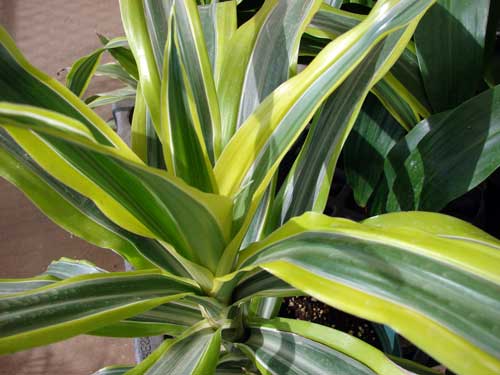
golden - a thin and short trunk with thick leaves 18-22 cm and 10-13 cm in length. Creamy white with pointed tops and dark green transverse stripes on both sides. The grooved petiole is 5-8 cm long. It grows only in humid and warm rooms, since its homeland is tropical West Africa.
Godzeff - undersized strong semi-shrubs, densely branching. Glossy green leathery leaves are arranged in 3-5 pieces, oval in shape, 3-5 cm wide and 7-10 cm long. good care will please you with fragrant flowers of yellow-green color.
Capitate - oval, petiolate leaves pointed towards the top. Dark green shiny upper side with whitish spots, while the underside is lighter in color.
Florida Beauty - its leaves are very similar to dieffenbachia with cream spots and a long, sharp top.
Gucker synonym Rumpha dracaena, dracaena Cordilina Rumfa , Aletriformis - a long trunk 1-2 m high, sometimes bifurcates. Sessile, leathery leaves are lanceolate-xixiform, 60-80 cm long and 4-5 cm wide, slightly narrowed and wavy at the base, the midrib stands out on the underside of the leaf, the edges are whitish.
Fragrant - with wide green leaves with wavy edges. Her spectacular views: Lemon Lime – leaves are bright green with a dark green stripe in the middle and creamy narrow stripes along the edge.
Linden - with yellow edges.
massange - with a yellow-green stripe. Surprise - a gray-green stripe in the middle and a yellow edge.
Deremskaya - has several types: Buse - dark green foliage with a white median stripe. Warnek - a gray-green stripe in the middle and white stripes along the edges. Shriveriana - a yellow-white graceful stripe along the edge of the leaves.
dragon tree - spectacular leathery leaves of a bluish color are widely used in interior design in cool, bright rooms. In summer, the plant is watered abundantly (do not forget about the periods of "drying"), and in winter with caution. Dracaena Draco is a long-liver, the oldest is 600 years old, its branched trunk is 15 m in girth, and its height is more than 20 m.
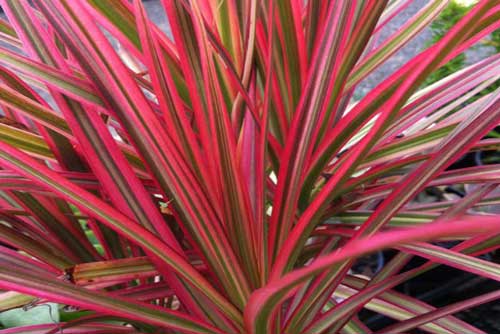
Pots with dracaena are placed in a bright room, protected from direct sunlight, with moderate humidity. The temperature there should not be lower than 16-18 C, and in spring and summer 20-25 C.
Throughout the year, the soil substrate should be moderately moist, but with periods of drying, and the foliage must be constantly sprayed. You can wipe the foliage with a damp cloth and even sometimes arrange a “shower”.
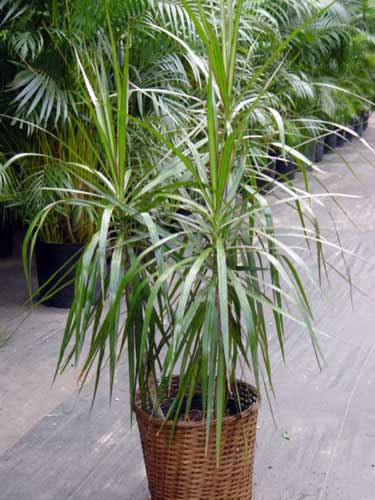
Dracaena love humidity, but can also get used to dry air. In semi-shaded interiors, this is a wonderful addition! However, variegated forms need more light.
Mineral complex fertilizers should be applied twice a month. The dormant period of dracaena is not particularly pronounced. To give the leaves a glossy look, you can cover them with liquid wax.
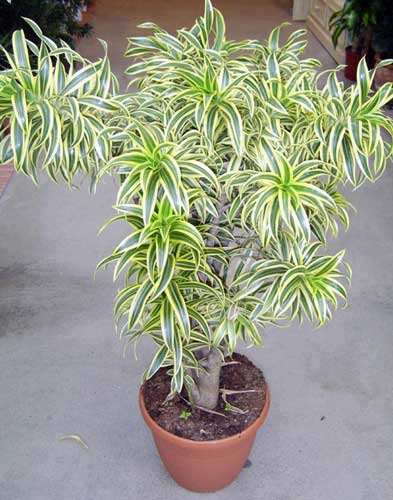
Dracaena reproduce in different ways:
- cut top - you can put the top of your head in water with coarse-grained soil at the bottom (5 cm) and wait for milk sprouts to appear, or you can plant it directly in the ground. The rooting period lasts from 1 to 2 months.
- seeds - in this way only green-leaved varieties are possible. Sowing is done in March-April, shoots will appear in about a month.
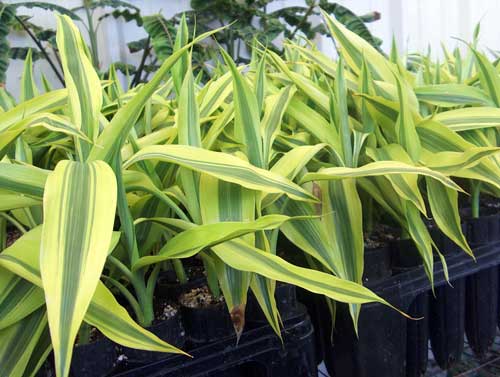
- cuttings - in dracaena, the leaves grow only in the upper part of the trunk and they do not live long, after about two years the lower ones begin to turn yellow. As soon as the trunk becomes noticeable, it is cut to 30 cm and used for cuttings.
New rosettes grow in place of the pruning, and the plant becomes even more beautiful (at this time it is recommended to reduce watering until new shoots grow).
- parts of non-lignified stems - on the trunk (just below the leaves) an incision is made (from bottom to top) up to half of the trunk and a piece of a match is inserted so that the stems do not connect.
Then they wrap this place with wet moss and tie it with twine.
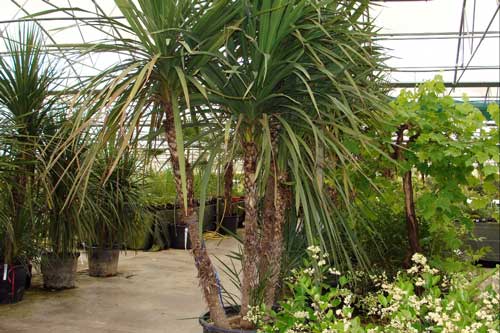
It is recommended to transplant young plants once a year, and adults once every 3-4 years in the spring. The signal for transplantation will be the roots that fill the entire volume of the pot. It will be better if you substitute a half-cut pot to the incision site or wrap it with a funnel made of cardboard.
A funnel or pot is filled with nutritious moist soil, roots will quickly grow in it. After the growth of new roots, it will be possible to separate the upper part and transplant the plant to a new place.
The remaining plant can be cut into cuttings 5-7 cm long, and planted obliquely in a greenhouse for rooting in a mixture of peat. The remaining stump (from 5 to 10 cm) is left for the formation of new shoots of a young plant.
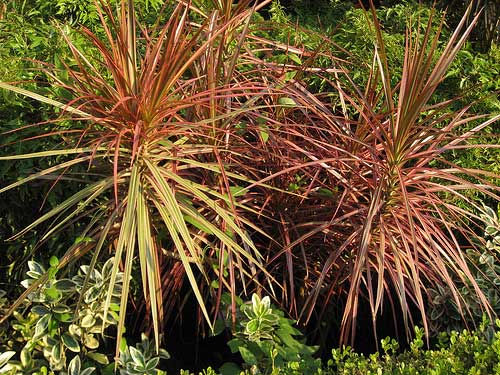
For transplantation, a nutrient substrate of slightly acidic pH, rich in humus, is used. It can consist of: 4 parts of sod and 2 parts of leafy earth and 1 part of sand.
Also, when transplanting, it will be possible to add soil mix with pieces of brick chips and charcoal, but without sand.
On a bucket of earth take 0.5 liters of brick chips and three handfuls of fine charcoal. Brick chips will collect excess moisture and increase the friability of the soil, and charcoal will protect against decay.
Don't forget the drainage pad. In dracaena growing in large containers (pots, tubs), it is recommended to change once a year upper layer soil (2-3 cm).

The most important thing in caring for dracaena is watering. . With frequent watering, the roots can rot, which will undoubtedly affect the entire plant. Many will perceive these changes as dry air and will begin to water and spray even more.
And this can be detrimental to some species, especially at low temperatures in winter.
The brown edges and tips of the leaves indicate dry air, drafts and insufficient watering. Also, brown spots appear due to low watering.
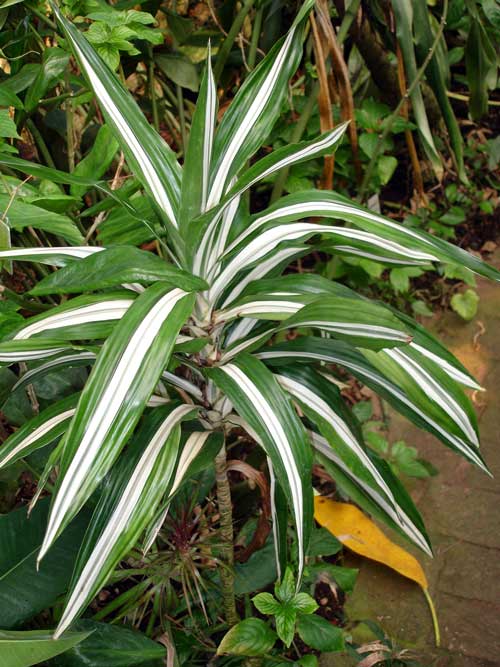
Soft, curled leaves with brown edges signal a low room temperature or large day-night swings.
About the disadvantage nutrients yellowed leaves will tell in the earth and dry air.
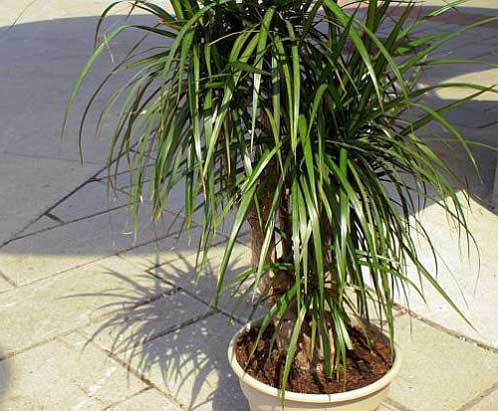
If the lower leaves begin to turn yellow while the upper part remains in the foliage, then you can rejuvenate the dracaena by cutting off the upper part and rooting it.
If the room is too light or the plant is burned by the sun's rays, then dry light spots will appear on the leaves.
![]()
Dracaena is affected by: thrips, aphids, scale insects, spider mites and mealybugs.
The dracaena flower, whose name translates as "female dragon", is referred to in some Russian dictionaries as "dragon". Many species are suitable for home culture, but most exotic forms can only be kept in heated greenhouses. Some varieties of dracaena have fragrant flowers(for example, fragrant), but most often the leaves determine the decorativeness of this home palm tree.
Dracaena or dragon tree (Dracaena) belongs to the Asparagus family. Homeland - the tropics of Africa and Asia.
The description of the dracaena is similar to the description of the cordilina, but the dragon tree as a whole has less spectacularly colored leaves and is distinguished by a simple but very expressive variegation and graphic outlines. The main differences are in the color of the roots (in dracaena they are yellowish, in cordilins they are white) and in the presence of only one seed in the nest of the fetus (there are three in cordilins).
Most types of home dracaena impress exotic plants although they are actually very hardy. This makes them very popular houseplants.
V in large numbers dracaena grow in the Canary Islands. Their famous resin, which flows from a wounded trunk - "dragon's blood" - has been used since time immemorial in religious ceremonies, in particular for embalming mummies. Interestingly, dragon trees are able to bleed their scarlet blood only in old age. Young trees do not have this property. Crying "bloody" tears (gum) and related to the Canarian dragon tree from the island of Sokota, located off the opposite coast of Africa, in the Indian Ocean.
An old Indian story related to dracaena has survived to this day. Many centuries ago, a huge dragon got into the habit of Socotra, which attacked elephants. It was huge and scary, and none of the animals could escape from it. Attacking elephants, he drank all the blood of his victim. But one day one old elephant, defending himself, fell on the dragon and crushed it. The place where the unequal battle took place was completely saturated with the blood of both animals. And a few years later, trees began to grow on this place, which were called "dragon trees". The peculiarity of these trees is that bloody red resinous spots appear on their trunks, which the locals call "dragon blood".
Dracaena- perennial, ornamental, evergreen shrub or a small tree. The stems of the dracaena are lignified. The trunk is smooth.
The leaves are leathery, rigid, linear, usually flat, in the form of an apical rosette, without cuttings (sessile). Their shape is lanceolate or narrow-lanceolate, usually they are collected in whorls. Depending on the species, they can be located either along the entire stem or crown the top of the stem with a lush bunch. The color of the leaves can be smooth green, speckled or striped (white or yellowish stripes along the edges of the leaves or a light green stripe in the middle with the main dark green color).
Most dracaena flowers are white or pink, opening at night, with a pleasant smell, especially fragrant dracaena. Collected in inflorescences, reaching a length of more than 1 m. It rarely blooms indoors.
Most popular:
 D. reflexed ‘Song India’ (D. reflexa ‘Song of India’) |
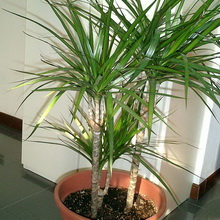 D. bordered (D. marginata) |
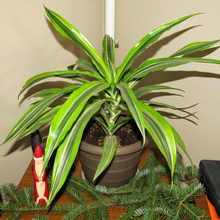 D. deremenskaya (D. deremensis) |
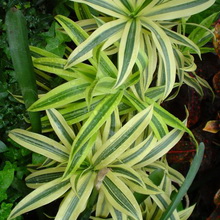 ‘D. bent ‘Varieshta’ (O. reflexa ‘Variegata’) |
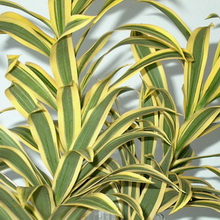 ‘Yellow Stripe’ (‘Yellow Stripe’) |
D. canarian, or dragon tree (D. draco) |
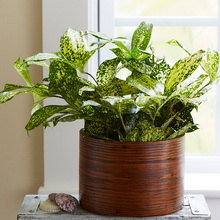 D. Godseffa (D. godseffiana) |
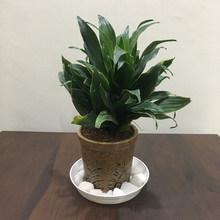 D. compact (D. compacta) |
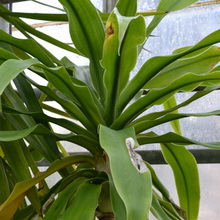 D. Hooker (D. hookeriana) |
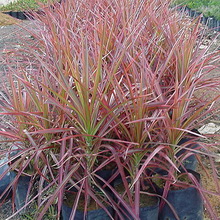 D. bordered ‘Tricolor’ |
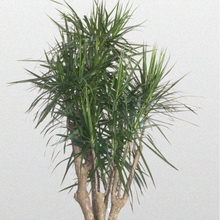 D. belted (O. cincita) |
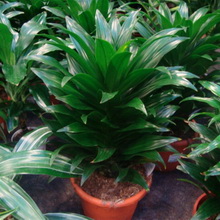 Bausei' ('Bausei') |
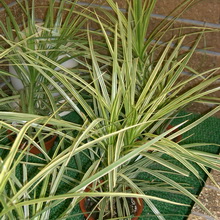 D. elegant (D. concinna) |
Green leaf types:
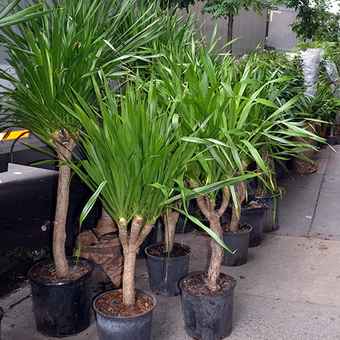
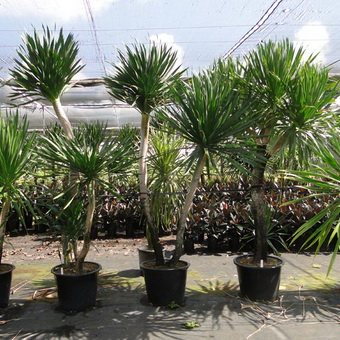
D. arborea (Willd.) Link. Trunk up to 12 m tall. Leaves up to 100 cm long and 6–8 cm wide in the middle, sessile, strong, green, with prominent veins below. Homeland - tropical East Africa to Angola. Cultivated in warm areas.
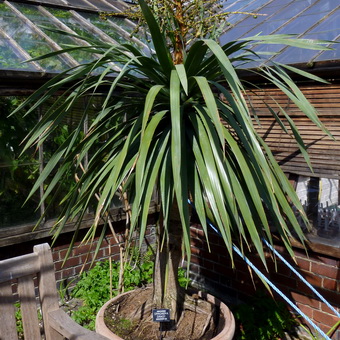
![]()
D. draco - D. Canary, or Dragon tree. Plants up to 18 m high and 4.5 m in diameter at the base of the trunk; each branch of branching ends with a dense bunch of grayish-green, leathery, linear-xiphoid leaves 45–60 cm long and 2–4 cm wide in the middle of the plate, somewhat tapering towards the base and pointed towards the apex, with prominent veins. The name of this type of dracaena is determined by its natural conditions habitat - it grows in open rocky places of the Canary Islands.
Reproduction is simple - seeds and apical cuttings. D. draco also thrives in cool rooms, while the rest of the green leaf dracaena are warm indoor plants.
The most interesting among them are:
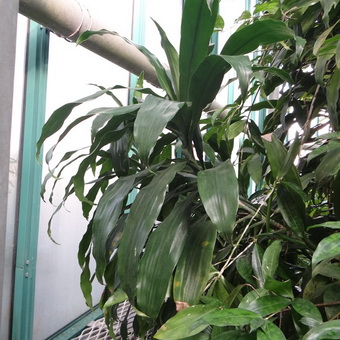
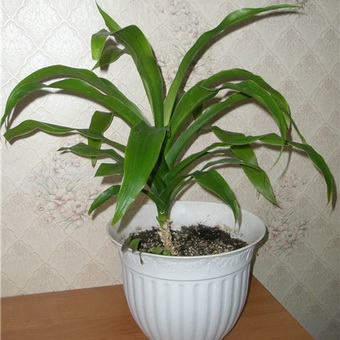
D. hookeriana C. Koch (D. rumphii Regel) – D. Hooker. The trunk is 1 to 2 m high, sometimes bifurcating. The leaves are leathery, sessile, with whitish edges and a midrib slightly protruding on the underside of the plate. grows in South Africa. Available garden varieties. Cultivated in warm areas.
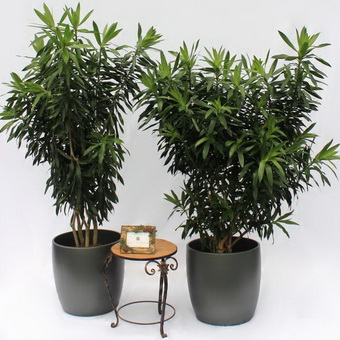
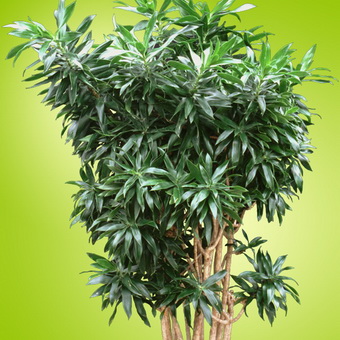
D. reflexa Lam. - D. bent. Trunk up to 5 m, sometimes branching. The leaves are lanceolate, 12–16 cm long and up to 2.5 cm wide in the middle, green, dense, leathery, with thin veins. Panicle loosely branched. Homeland - the island of Mauritius. There are many garden forms and varieties. Cultivated in warm areas.
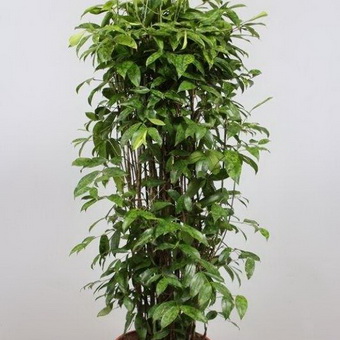
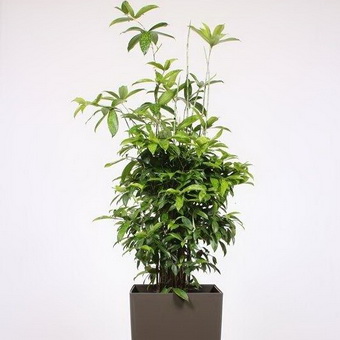
D. surculosa Lindl. - D. shoot-forming. Shrubs up to 3 m tall, with numerous lignified branching branches.
Pay attention to the photo - the leaves of this dracaena are located 3 or distant from each other, up to 16 cm long and up to 6 cm wide in the middle, triangular at the base, elongated-pointed at the top, leathery, green, in yellow spots, on the lower side with prominent veins:
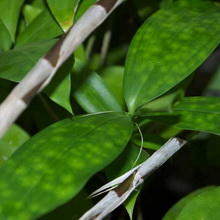 |
 |
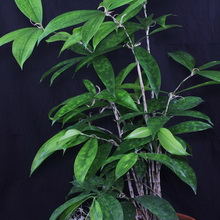 |
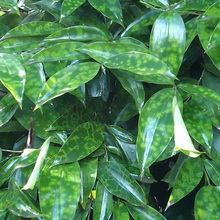 |
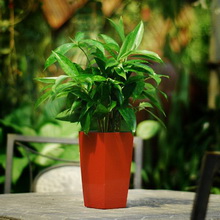 |
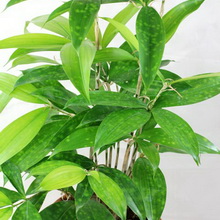 |
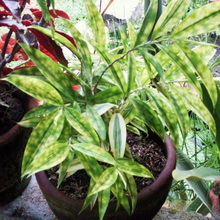 |
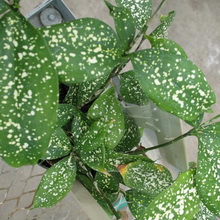 |
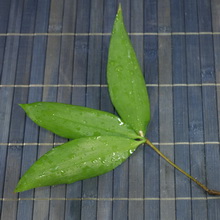 |
Apical inflorescence. Flowers green-white, fragrant. Homeland - Sierra Leone. There are a number of varieties.
Variegated species:
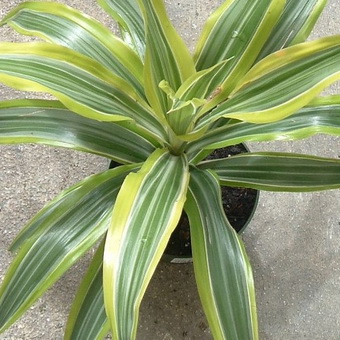
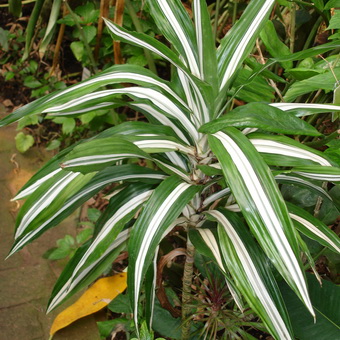
Dracaena deremensis (Dracaena deremensis)- perennial, tall (up to 3 m), evergreen plant from the agave family, native to the tropics of Africa. The leaves are linear-lanceolate, up to 50 cm long, 5-6 cm wide, sessile, vaginal, dark green, with a yellowish-white stripe along the edge (variety ‘Shriveriana’). Flowers in racemes; fruit berry-like, orange. In room conditions, it blooms very rarely. Dracaena is often confused with cordilina. In the interior, they are used when creating group compositions, as well as in winter gardens. Homeland - tropical Africa.
In culture, two varieties are more common and especially attractive; they are suitable for rooms and culture in warm rooms.
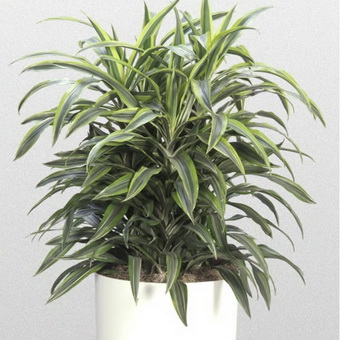
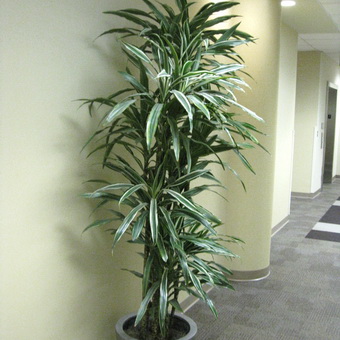
Bausei- leaves often drooping, with a white stripe along the midrib, with dark green lateral stripes on each side.
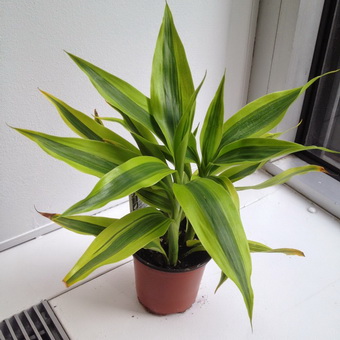
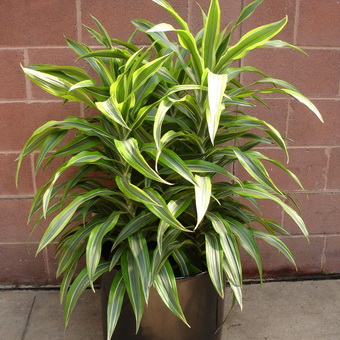
Warneckii- the leaves are greenish, with a white stripe in the middle and with light and dark green strokes.
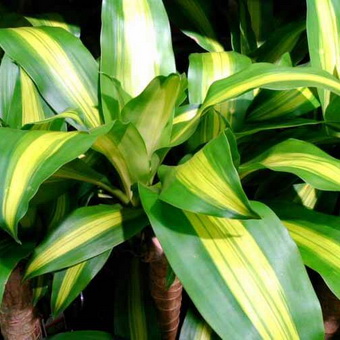
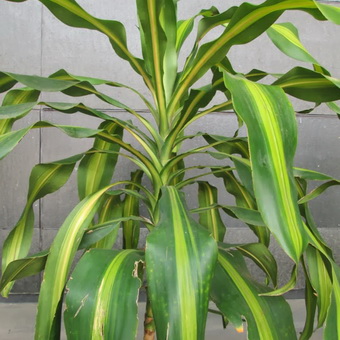
D. fragrans (L.) Ker-Gawl. - fragrant. The plant is tree-like, up to 6 m high. The leaves are arcuately curved, hanging, wide, up to 80 cm long, wavy along the edge, with a prominent midrib, variegated. The flowers are whitish or yellowish-green, fragrant, collected in paniculate inflorescences.
These photos show what a dracaena flower of different types looks like:
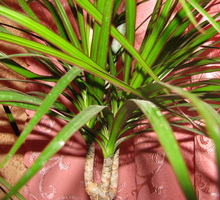 |
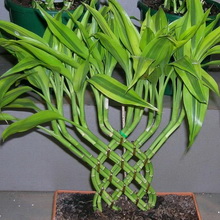 |
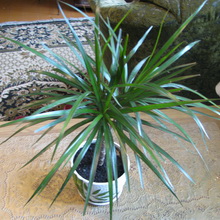 |
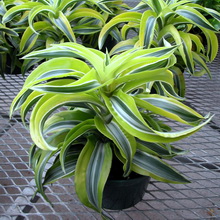 |
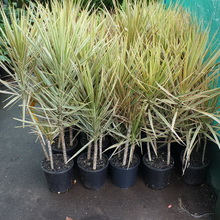 |
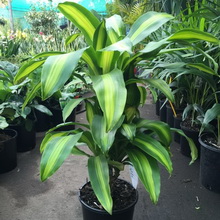 |
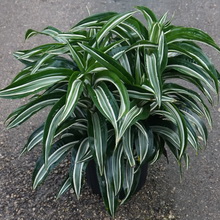 |
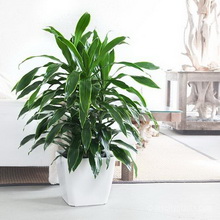 |
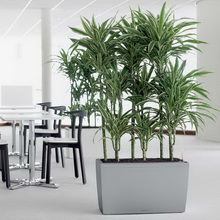 |
In culture, it has many valuable ornamental varieties.
Widespread:
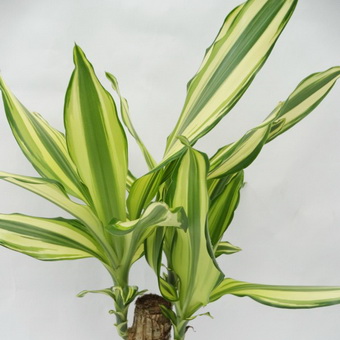
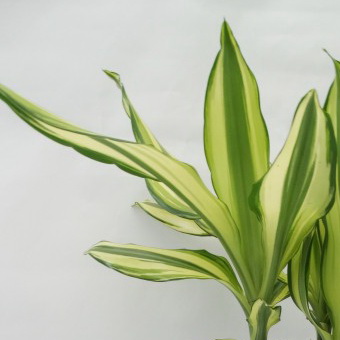
Lindenii- trunk up to 6 m tall, leaves with a wide green stripe, in the middle with more or less wide creamy white stripes, wide, yellowish-green on both sides (old leaves are green at the edges).
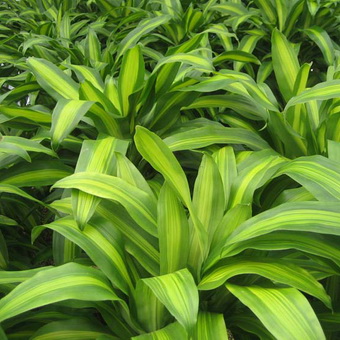
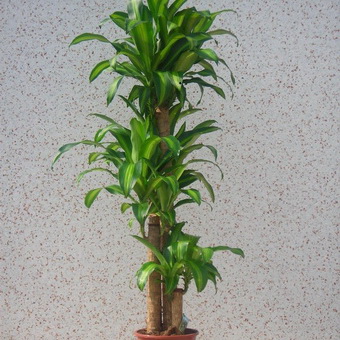
Massangeana- leaves in yellowish-green stripes in the middle, from which narrow dark green stripes extend, and on both sides - wide dark green.
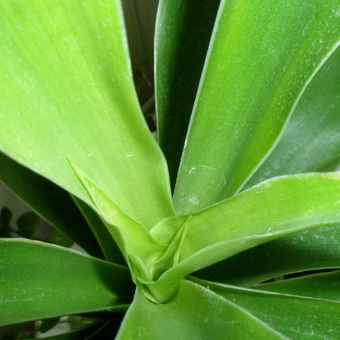
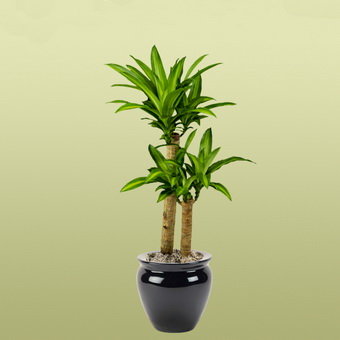
Rothiana- leaves are dense, leathery, dark green, white at the edges.
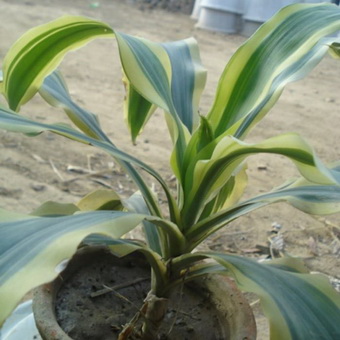
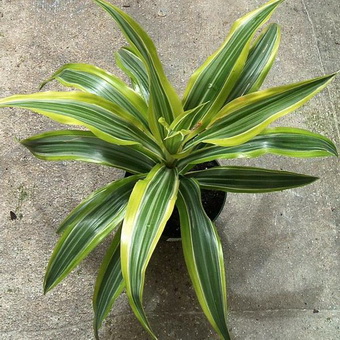
Victoria- leaves with wide yellowish lateral stripes, turning green at older leaves.
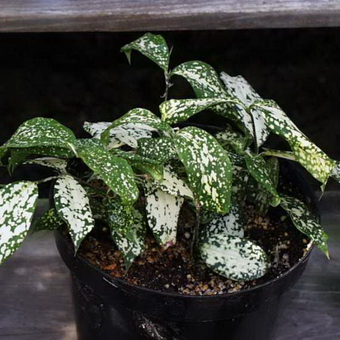
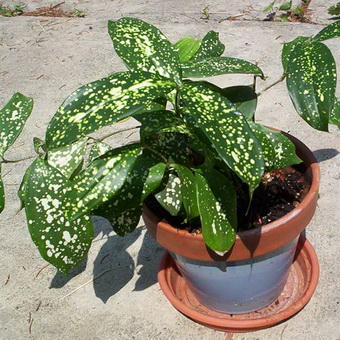
D. godseffianahort. ex Sander – D. Godsefa. The plant is semi-shrub, undersized, strongly branching, with erect thin trunks.
As can be seen in the photo, the leaves of this houseplant dracaena are broadly ovate, leathery, shiny, 7–10 cm long, pointed at the ends, sometimes wavy along the edge, green with yellow, cream and pinkish spots:
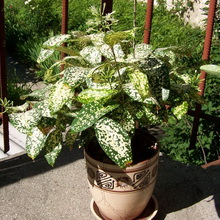 |
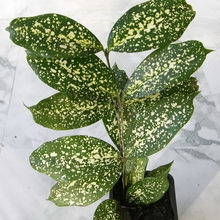 |
|
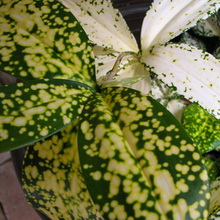 |
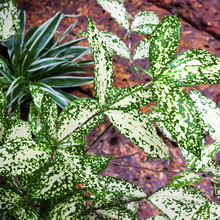 |
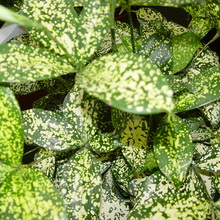 |
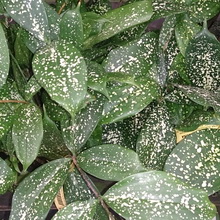 |
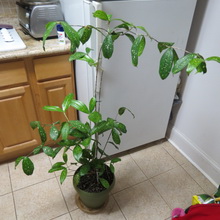 |
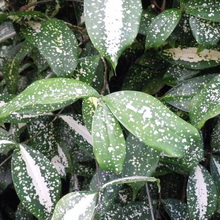 |
The flowers are yellowish-green, with a pleasant aroma, collected in axillary racemes.
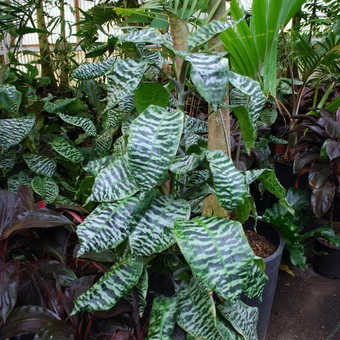
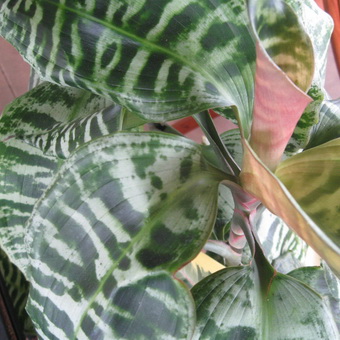
D. goldicanahort. ex Baker – D. Golden. Plants with a short thin trunk. The leaves are thick, up to 22 cm long and 10–13 cm wide in the middle, pointed at the top, creamy white, with dark green transverse stripes on both sides. Homeland - tropical West Africa (Guinea). Very beautiful plant, its culture is possible only in warm rooms, at a temperature of 20–22 ° C and high humidity.
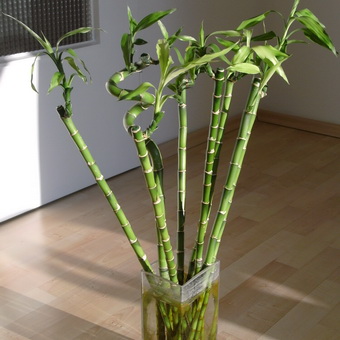
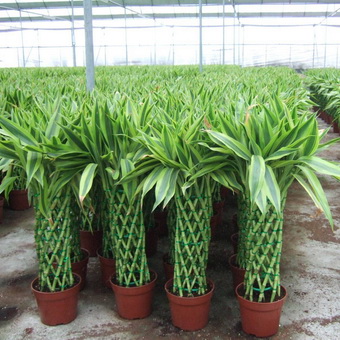
D. sanderianahort. Sander ex Mast. – D. Sander. Low-growing plants with a thin trunk, densely leafy. Leaves up to 20 cm long and 1–3 cm wide, green, in white and silvery-gray stripes (there are often few green areas on the plate). Homeland - Congo. Grown in warm areas good lighting, in winter at a temperature of 16–18 °C.
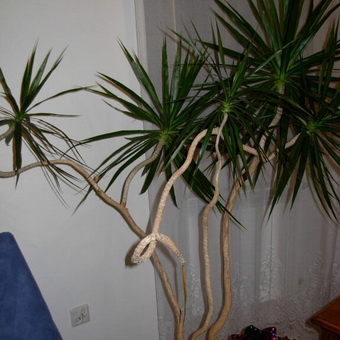
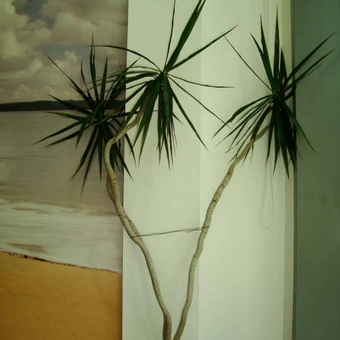
Dracaena fringed(D. marginata) - green leaf form. A tree-like plant with a serpentine twisted branching stem, often reaching a height of 3 m.
Look at the photo - this home flower dracaena leaves are narrow, linear, hard, pointed, up to 70 cm long, dark green, with a red border around the edge:
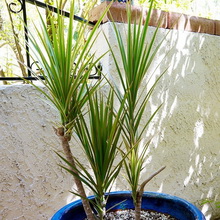 |
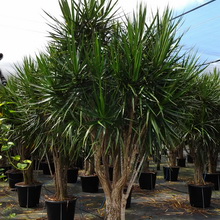 |
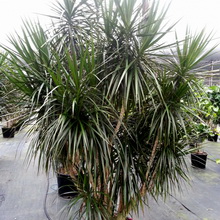 |
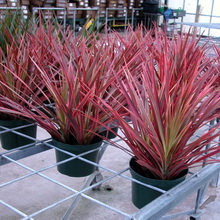 |
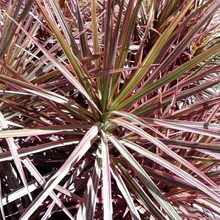 |
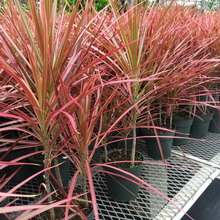 |
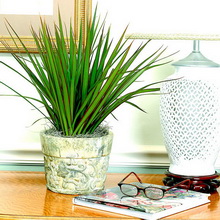 |
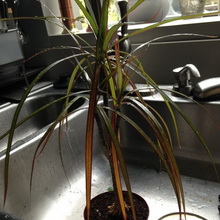 |
There are varieties with yellow and red stripes on the leaves, with a reddish-purple border, and also with a very wide red stripe along the edge, which makes the leaves themselves appear red.
Tall dracaena:
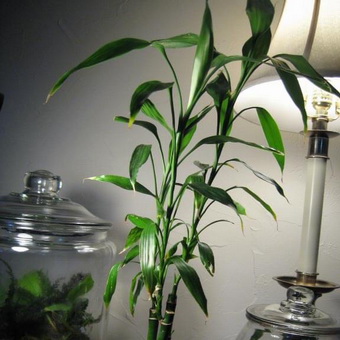
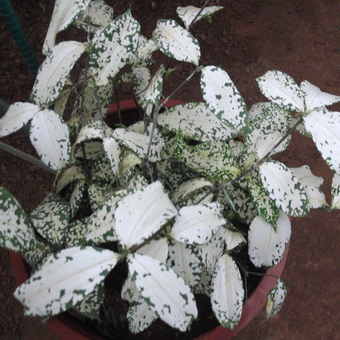
Compact dracaena: Dracaena sanderiana, Dracaena godseffiana.
The following describes how to care for a potted dracaena and how to propagate the plant.
Accommodation. Depending on the species, indoor dracaena can reach from 70 cm to 2 m in height, so when choosing a plant, you need to determine its place in your home in advance. Tall species are more suitable for winter gardens or office landscaping. Undersized grow well on the windowsill.
Temperature. Dracaena do not like strong heat. In order to properly care for the dracaena flower at home, as practice shows, it is necessary to maintain the optimum temperature in summer + 15-18 ° C, in winter 16-18 ° C.
Lighting. Indoors, dracaena grows best in diffused light. When grown at home, dracaena do not tolerate direct sunlight, preferring partial shade or diffused light. However, in full shade, they will also not be able to develop well, so you should not put them deep into the room - it is better to find a place near the east or west window. If it is not possible to place the dracaena near the window, artificial lighting is necessary. In addition, variegated species of dracaena need more light than green ones.
Watering. The plant is moisture-loving, from spring to autumn it needs abundant watering. Broad-leaved dracaena requires a lot of water, especially during the growth period. Narrow-leaved dracaena is watered less, avoiding prolonged waterlogging of the soil. From April to October - regular watering with water at room temperature. In winter, it should be watered rarely. When growing dracaena (dragon tree), it should be borne in mind that plants are equally sensitive to both stagnation of water in the soil and drying out of the soil clod.
Fertilizers. Top dressing is carried out with liquid fertilizers once every 2-3 weeks, only in summer.
Rest period. Not expressed.
Air humidity. Dracaena are not picky about air humidity, they can tolerate its lack. However, for better growth and development, when caring for indoor dracaena at home, the plant needs to take a shower from time to time and regularly wipe the dust from the leaves. In order to take care of a houseplant as carefully as possible, if in winter the flower is close to a heater or a central heating battery, it is advisable to spray it once a week.
Transfer. Dracaena are transplanted in the spring, with a strong growth, transplantation should be carried out annually. If the plant grows moderately, then once every 2 years. For transplantation, a substrate is prepared, consisting of a mixture of leafy, soddy soil and humus in equal parts, you can also add river sand. A thick drainage layer is laid at the bottom of the container.
The substrate is prepared from leafy and compost soil, peat and sand (3:2:1:1).
The video "Growing Dracaena" shows the care of flowers at home:
In the process of caring for indoor flower dracaena, you may encounter some problems.
The appearance of spots on the leaves. Reason: excess moisture in the soil or excessively dry air. You should spray the plant more often and reduce watering.
The appearance of honeydew, sooty fungus on the leaves. Reason: defeat by scale insects. You should wipe the leaves with soapy water or tobacco infusion, put the plant in a cool place and increase the humidity.
Yellowing and dropping of leaves. Cause: damage by spider mites. Spray the leaves with clean water at least 2-3 times a day.
The appearance of soft twisted leaves with brown edges. Reason: too low air temperature. In delicate species of dracaena, similar signs appear if left near a window on a cold night.
The appearance of brown spots on the leaves. Reason: too bright lighting. Move to a less lit area.
Plant wilting. Reason: wrong conditions for keeping dracaena. Need to adjust temperature regime and watering the plant.
The next section of the article is devoted to how to propagate dracaena by cuttings.
There are several ways to propagate dracaena. Variegated forms of dracaena can be propagated by non-lignified cuttings or air layers from the top of the plant.
To propagate dracaena at home, cut off the side shoot with stem cuttings, remove the leaves from it and cut it into pieces 7-10 cm long. The cuttings are planted in a substrate consisting of a mixture of peat and sand in equal parts. Before rooting, cuttings should be kept at a temperature of 21–25 ° C. Cuttings take root within 2-3 weeks. The cuttings are transplanted into the pot after the first leaves appear on them.
Apical cuttings are cut with a bunch of leaves; uniform temperature, substrate moisture and regular spraying of leaves are necessary for rooting. The cut top can simply be put in water, after a while the roots will appear. The place where the top is cut should be covered with paraffin. After some time, new shoots will develop from the lateral buds around the cut.
It is possible to reproduce the domestic dracaena palm with seeds that are sown in March in a light peat substrate, the seedlings are kept at room temperature.
Dracaena with green leaves can be propagated by both cuttings and seeds.
For ease of care when growing dracaena species D. godseffiana and D. sanderiana, they are often planted 3–5 specimens in pots.
Mainly used as an ornamental plant. Like cordilins, dracaena rarely bloom in rooms. But their catchy, graphically painted by nature leaves cannot but attract attention.
This rather large tapeworm can adequately decorate the corner of the living room or ennoble the composition of the winter garden.
Dracaena is not only ornamental plant, but is able to purify the air of residential and office premises, reducing the content chemical substances. Highly recommended for offices. They say that when the climate in the team is unfavorable, the dracaena begins to wither!
In the Canary Islands, a resin is extracted from the trunk of this plant, which is called "dragon's blood". The fibers of the leaves are similar to horse hair, which is used in the manufacture of brushes.
Dracaena.
Dracaena family. Homeland - tropical regions of Africa and Asia, the Canary Islands.
When choosing a dracaena for an apartment, it is necessary to take into account how much space it will be given, because. among the various types of dracaena there are giant and dwarf, and the usual form of the plant. Dracaena by appearance often confused with cordilins. To distinguish them, you will have to get the plant out of the pot. In dracaena, the roots are even and smooth in color from orange and yellow to light brown.
Dracaena deremensis (Dracaena deremensis)- slow growing plant, grows to 1.5 m and above. Leaves up to 50 cm long, about 5 cm wide, glossy, lanceolate. There is a variety with pure green leaves, but variegated varieties are more common. Some have one or more white or yellow stripes.
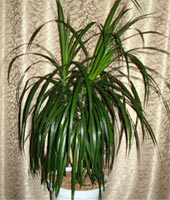
Dracaena bordered (Dracaena marginata)- a perennial plant growing up to 3 m in height, with a thick woody stem, which usually has little branching and is very bare. Leaves up to 50 cm long, about 1-2 cm wide, glossy, narrow-lanceolate. The color of the leaves is predominantly green, but depending on the variety, it may have yellow or red stripes. This is one of the most common types of dracaena, and not only varietal species Dracaena marginata tricolor (with narrow red and yellow stripes) or Dracaena marginata colorama (with wide red border), but also the wild species Dracaena marginata - with green leaves and a reddish-purple stripe along the edge.
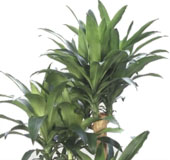
Fragrant dracaena (Dracaena fragrans)- has bright green leaves with a silver-gray stripe in the middle. It grows indoors up to 2 m in height. It blooms with fragrant white flowers. This is one of the best views dracaena. It is also not a very whimsical plant, which can withstand rather cool temperatures up to 10 ° C in winter.
There is another variety dracaena - Dracaena fragrans Stedneri. This plant is called "Chinese bamboo" or "bamboo of happiness".
Growing.
In general, dracaena are considered not a difficult plant, but it all depends on the species. Most unpretentious species- Bordered Dracaena, Dragon Dracaena and Godsef Dracaena - they endure shading and low temperatures in winter. Other species are mostly quite demanding plants.
Dracaena still need elementary care - wiping the leaves from dust, rejuvenating old plants, providing a dormant period that lasts from October to January.
For the summer, it is better to put the dracaena in the garden or on the balcony, providing shelter from the wind and bright sun. Uniform lighting from all sides in the open air contributes to a more uniform leafing of the plant.
Dracaena respond very well to the periodic loosening of the top layer of earth in pots in spring and summer. This improves soil aeration.
Location.
A bright place, partial shade, does not tolerate direct sunlight. Many consider dracaena to be a shade-loving plant, but in fact it will vegetate in a dark place. Intense light is needed for good growth and development. Variegated forms require more light than green leafed forms. If there is enough light in summer, then in winter the dracaena should be rearranged closer to the window, since in winter there is usually always not enough light. Dracaena grows well under artificial lighting.
Temperature.
Moderate, not below 15°C, most dracaena prefer a cool overwintering at a temperature of 10-12°C.
Plentiful in summer, moderate in winter, but subject to room temperature. Does not tolerate stagnant water in a pot or drying out an earthen coma. Dracaena are suitable for growing hydroponically.
Broad-leaved dracaenas require more watering during growth than narrow-leaved dracaenas, as their leaves evaporate more moisture.
Air humidity.
Dracaena are resistant to dry air, but require regular foliar spraying when kept in rooms with central heating in winter. Periodically give the plant a warm shower to wash off the dust and refresh the plant.
Maintain appearance.
It is typical for dracaena to lose the lower leaves, while the upper part of the plant remains leafy. You can only rejuvenate the plant by cutting off and rooting the top. You can also plant younger plants in a pot to an old dracaena, in a group they will look more spectacular.
Transplantation.
Spring every two years. The soil is a mixture of heavy sod and leaf soil, rotted manure or greenhouse soil with the addition of sand. The roots of dracaena are more located in the upper layer of the soil, so they make a lot of drainage in the pot.
When transplanting dracaena, add pieces of charcoal (birch) coal and brick chips to the fresh soil mixture, in addition to sand. On a bucket of earth, three handfuls of coal and 0.5 liters of brick chips. Pieces of coal prevent the development of rotting processes, and brick chips increase the friability of the soil and collect excess moisture, which is very important, because dracaena do not tolerate excess and stagnant water.
Fertilizer.
During the growth period from April to August, every two weeks, dracaena are fed with special complex fertilizers for indoor plants. You can use "Rainbow", "Ideal", "Giant", etc.
Reproduction.
Apical cuttings(with the use of heteroauxin and heating of the soil), pieces of the trunk, not less than 10 cm long, layering. If you cut off the top of the dracaena, you can put it in a jar of water, adding a few pieces of charcoal there, after about three months the roots will appear and the plant is planted in a pot. At the site of the top cut on the mother plant, new shoots from lateral buds will appear. Variegated dracaena reproduce only vegetatively, and green forms, in addition, also by seeds.
Diseases and pests.
It is damaged by spider mites, scale insects, mealybugs, thrips, leaf spot, black fungi and nematodes.
Brown plaques of scale insects cover the surfaces of leaves and stems, suck out cell sap. Leaves lose color, dry and fall off.
Control measures. For mechanical cleaning pests, the leaves are wiped with a soapy sponge. Then spray the plant with a 0.15% actellik solution (1-2 ml per liter of water).
The appearance of thrips is promoted by high temperature and low humidity. On the underside of the leaf, thrips lays numerous colonies, and light dots appear on the upper side of the leaf. As a result, the upper side of the leaf becomes grayish-brown with a silvery sheen.
Control measures. The plant should be sprayed, if necessary, repeatedly with insecticides (fitoverm, decis, actellik, inta-vir).
Aphids also sometimes affect dracaena. They damage the leaves from the underside, the tops of the shoots. Damaged parts become discolored, the leaves curl, turn yellow and fall off.
Control measures. Spraying with derris, fitoverm, decis, actellik, inta-vir. In case of severe damage, repeat the treatment.
Causes of various spots on the leaves
Lack of heat and dry air in the apartment, lack of minerals are the main causes of various spots on the leaves. Most of the diseases of dracaena are physiological, not infectious. Why does dracaena turn yellow or why does dracaena dry?
1. Yellowing and drying of dracaena leaves (dracaena turns yellow)
. Dracaena leaves live for about 2 years, and then they gradually turn yellow, starting from the top, and dry out. The natural death of the lower leaves of dracaena proceeds slowly. So that the plant does not lose its decorative effect, the tips of dying leaves are cut off to healthy tissue. Even the third and smaller part of the cut sheet will still work for the dracaena, so you do not need to remove the entire sheet at once. But if the younger leaves of the dracaena turn yellow and dry out, it means that the plant is watered excessively or irregularly. Dracaena needs the soil to dry out from above, but the earthen lump never dries up.
2. Brown tips and edges of dracaena leaves
talk about insufficient humidity. Spray your plant regularly and remember that the earth ball should not dry out. Cold drafts can also cause brown spots to develop along the edge of the leaf.
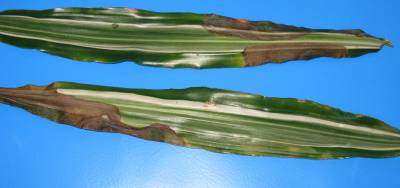
3. Brown wet spots on dracaena leaves
. If the spots are wet at first and then dry out, this is a sunburn.
4. The tips of young dracaena leaves turn black and dry out.
If the plant has not been transplanted for a long time, 3-4 years, salts accumulate in the old soil, which interfere with the flow necessary elements nutrition. An overdose of fertilizers also makes the land unusable. The absorptive roots are dying. An urgent replacement of the soil is needed.
5. The tips of old leaves turn black, poor growth.
A sign of malnutrition. Or the soil is light, but without humus and peat. Either heavy and clayey, poorly wetted, shrinks. Need to be transplanted into new land containing equal parts of soddy, leafy soil, peat and sand.
6. Decay of dracaena leaves.
Rotting starts at the top of the leaf. Damaged tissues are watery brown in color. They are separated from the healthy part of the leaf by a green stripe, made of softened tissue that did not have time to change color. Symptoms of the disease are easily confused with bacterial rot. In bacteriosis, a yellow border is characteristic. The cause of non-infectious leaf rot is the lack of heat, lighting and constant waterlogging. Dracaena roots should not get wet in water or mud. Heavy or dense loose soil can also cause leaf rot. Air must be supplied to the roots for respiration. Measures to combat this rot - the creation optimal conditions development of dracaena and removal of affected leaves.
7. Dracaena leaves become dull, lifeless, hang.
If the plant is frozen under the window, then you can try to save it by frequent spraying with warm water and heat. If it is cold in the room, less than 15 degrees, it is necessary to check the roots - they may have rotted. rotten roots remove and replant the plant, or root its crown.
8. Leaves fall off, dracaena shoots dry up.
With constant overflow and hypothermia of the earthy coma, the roots rot and the leaves quickly fall off. Rot can also go to the stem. Dracaena can only be saved by cuttings.
infectious diseases
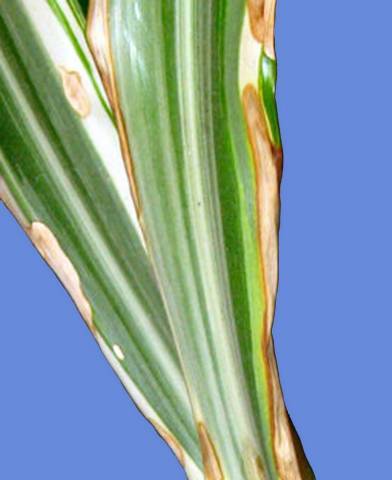
1. Light brown spotting or alternariosis, or concentric spotting. On the leaves and stems of dracaena are rounded light brown, dry spots with a light center. It shows light and dark concentric stripes. Later, the affected tissue becomes almost black from small black tufts - sporulation of the fungus. To get rid of the disease, spraying with fungicides is necessary. It is best to apply foundationol (1 g per 0.5 l of water). You can spray with a solution of topaz, oxychoma or other copper-containing fungicides. The solution for spraying is prepared, strictly following the instructions on the packaging of the drug. Spraying is carried out 3 times, after 10 days.
2. Light brown spotting with a dark border or heterosporosis. The spots on the leaves are elongated, rounded, light brown, with a dark red border around. From above, an olive coating is formed from the sporulation of the fungus. Spraying with fungicides is required.
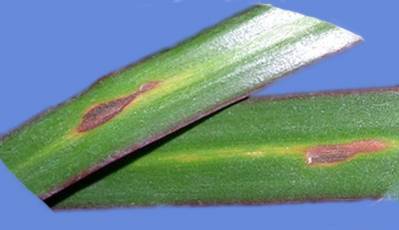
3. Brown spotting or phyllostictosis. On the leaves of dracaena there are large pale brown, drying, rounded or irregular spots, with a yellowish-greenish border. Later, small black dots (pycnidia) form on them. Phyllosticosis most often affects adult and aging leaves with an excess or lack of moisture in the soil and in the air. Requires the use of fungicides.
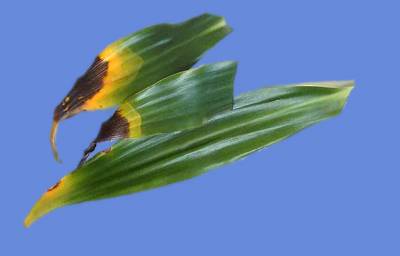
4. Softening and rotting of the tips of the leaves or bacteriosis. The tips of the leaves darken, become watery and brown. Or wet, rotting, brown spots form on the leaves. Between the healthy and rotten part of the leaf is an oily, yellow, wide stripe. Droplets of liquid often appear on the spots; when dried, they turn into a film. Sometimes small rounded ulcers form on the stems and petioles. contribute to the development of bacteriosis high humidity, waterlogging of the soil, heat and high air temperature, lack of phosphorus and potassium, high soil pH (alkaline). It is almost impossible to cure the affected plants, it is better to destroy them. Spraying diseased plants with water promotes the spread of the disease.
5. Brown longitudinal dashes and spots on the leaves. The disease is caused by the tomato spotted wilt virus. The plant is stunted, usually young leaves are very small and deformed. Affected plants are destroyed.
Read more about these pests in the section
Dracaena are amazingly beautiful and exotic plants. Now they can be found in our homes quite often. Dracaena are most often unpretentious in care and do not require constant attention, which is why they have earned the love of many flower growers.
The scientific name of the genus, Dracaena, means "female dragon". As the Russian name of the genus, the word "dracaena" is usually used, but Vladimir Dahl has another Russian name in his Dictionary - "dragon".
Dracaena (Dracaena) belong to the Dracaena family. They are common in tropical and subtropical regions of Africa and Asia, in Madagascar and the Canary Islands - here dracaena are used not only as decorative plants, but also as technical plants. Dracaena leaf tissue contains fibers having elastic properties(like stubble and horsehair). These fibers are widely used to make brushes. The resin of the tree is also valued, which the locals call dragon's blood.
Dracaena outwardly resemble palm trees, to which, however, they have nothing to do. Dracaena are very spectacular, exotic and picturesque plants. Non-branching stems of dracaena young age densely covered with numerous long lanceolate or broad leathery, sessile (without petioles) leaves - green, variegated or with longitudinal stripes (white, yellow or pink). Over time, the slender trunk of the dracaena becomes tree-like and becomes bare, while well-groomed dracaena acquire a majestic appearance. In some species of dracaena, the leaves are collected in bunches at the top of the stem, forming a crown (really, like a palm tree), while in other species they are located on the stem in whorls or spirally. Dracaena roots are club-shaped, yellow-red on the cut; shoots are not given. In room conditions, dracaena bloom extremely rarely, forming panicles with an abundance of small white or pinkish fragrant flowers; the fruit has one seed. Dracaena live very long and grow slowly.
Dracaena prefer light, but shaded places from direct sunlight or diffused light (most dracaena develops better on windows facing west and east). Types of dracaena with dark green leaves tolerate significant darkening, and variegated dracaena need bright light (otherwise the leaves will lose their original color and turn green). Suitable and artificial lighting. Optimum temperature the content of dracaena during the year is in the range of 18-25 degrees; variegated forms of dracaena are very fond of warmth, and the rest endure a decrease in temperature in winter to 10-13 degrees.
Watering the dracaena should be moderate and regular (more plentiful in summer, rare in winter) - it is important not to allow waterlogging or drying of the substrate, otherwise the roots will quickly rot and the leaves will fall off, the plant may die. Excess water after watering from the pan must be removed. Dracaena love wet air and frequent spraying. From the leaves periodically you need to wash off the accumulated dust. Water for irrigation and spraying should be settled, and preferably filtered. If there are a lot of fluorides in the water, then necrosis (non-infectious spotting) may develop in very sensitive dracaena. Wrong watering dracaena is the cause of the drying of the tops of the leaves; from dry air, the edges of the leaves become brown. Also, when the air is very dry during the heating season in winter and in summer heat the likelihood of damage to dracaena by pests increases: scale insects, mealybugs, spider mites.
Dracaena do not tolerate leaf sheen spray.
From April to September, dracaena require fertilizer 2 times a month. During this period, it is fed with special complex fertilizers for indoor plants. Once every two years, dracaena are transplanted (in spring or summer) into a substrate from a mixture of sod, leaf, compost soil, peat and sand in equal parts; The pot must have a drainage hole. When transplanting dracaena into a fresh soil mixture, in addition to sand, you can add pieces of charcoal (birch) coal and brick chips. On a bucket of earth, three handfuls of coal and 0.5 liters of brick chips. Pieces of coal prevent the development of rotting processes, and brick chips increase the friability of the soil and collect excess moisture, which is very important, because dracaena do not tolerate excess and stagnant water.
Dracaena respond very well to the periodic loosening of the top layer of earth in pots in spring and summer. This improves soil aeration. If the top layer of earth in a pot with dracaena is covered with a white crust (salt deposits from water and soil), then this earth must be removed and replaced with fresh one.
For the summer, it is better to put the dracaena in the garden or on the balcony, providing shelter from the wind and bright sun. Uniform lighting from all sides in the open air contributes to a more uniform leafing of the plant.
All dracaena propagate by vegetative-apical cuttings, which, at a temperature of 20-22 degrees, are rooted in wet sand under glass for 2-3 weeks. It is also possible to propagate dracaena (as well as dieffenbachia, yucca, philodendron) with stem cuttings (placing them vertically in pots or laying them horizontally), if the stem stem has at least one eye. If you cut off the top of the dracaena, you can put it in a jar of water, adding a few pieces of charcoal there, roots will appear in about three months, and the plant is planted in a pot. At the site of the top cut on the mother plant, new shoots from lateral buds will appear. Vegetative propagation dracaena can be carried out all year round, but in the spring-summer period, rooting is more active. Dragon dracaena also reproduces by seeds.
Scale insects and thrips are the two main enemies of dracaena. Scale insects suck out cell sap, so their appearance is characterized by brown plaques on the surface of the leaves. Leaves lose color, dry and fall off. For mechanical cleaning of pests, the leaves are wiped with a soapy sponge. Next, the plant must be sprayed with a solution of Actellik (1-2 ml per liter of water).
The appearance of thrips is promoted by high temperature and low humidity. On the underside of the leaf, thrips lays numerous colonies, and light dots appear on the upper side of the leaf. As a result, the upper side of the leaf becomes grayish-brown with a silvery sheen. If you notice such changes in your dragon tree, it should be sprayed (repeatedly if necessary) with insecticides (phytoverm, decis, actellik, inta-vir).
Another pest of dracaena is aphids. They infect plants much less frequently. Aphids damage the tops of dracaena shoots and leaves from the underside. Damaged parts become discolored, the leaves curl, turn yellow and fall off. Spraying with derris, fitoverm, decis, actellik, inta-vir will help to defeat aphids, if necessary, re-treatment is carried out.
Brown tips or edges of the leaves indicate that the air is too dry in the room, cold drafts or the plant is not watered well enough. The leaves are twisted, soft, with brown edges appear in dracaena if the room temperature is too low or it is warm during the day and much colder at night. If the leaves of the dracaena turn yellow, it means that the air in the room is too dry or there are not enough nutrients (nitrogen) in the soil. Light dry spots on the leaves - a sign sunburn and too intense lighting. Dracaena needs shading from direct sunlight.
It is typical for dracaena to lose the lower leaves, while the upper part of the plant remains leafy. You can rejuvenate the plant by cutting off and rooting the top, or plant younger plants in the pot to the old dracaena, which together will look very impressive.
The 6 most common types of dracaena are especially suitable for indoor gardening:
| Read: |
These species gained their popularity due to their unpretentiousness and extraordinary appearance. Dracaena can be used both as tapeworms and in compositions for decorating apartments, winter gardens, offices, and public spaces. When choosing dracaena for an apartment, you need to have a very good idea of where exactly you are going to give it a place, because among the variety of dracaena species there are giant, dwarf, and ordinary-shaped plants.
In the countries of South and Central America, dracaena is called the "tree of happiness." This name for the dracaena appeared due to the Aztec legend, according to which a warrior who fell in love with the daughter of the high priest, trying to get the consent of the girl’s father for marriage, was forced to water a stick stuck in the ground by the priest so that leaves appeared on it. If the leaves had not appeared on the stick after 5 days, the warrior would have been threatened with death. But, fortunately, the leaves appeared - the dracaena grew, and the priest was forced to give his daughter as a wife to the warrior. Since then, many believe that a small part of the dracaena trunk, cut off at midnight on a full moon, brings happiness in love.
Some houseplant lovers believe that dracaena heals. For example, fragrant dracaena has a positive effect on the musculoskeletal system and skin. It is believed that its mere presence contributes to the rapid healing of skin wounds and cracks, and any skin diseases. Dracaena can affect posture, helping to keep it straight. They say that it favorably affects even the condition of the teeth. All these observations are not scientifically confirmed, but many people continue to believe in the miraculous power of this dragon tree.
Material selection: Anna Razumovskaya
Gallery: